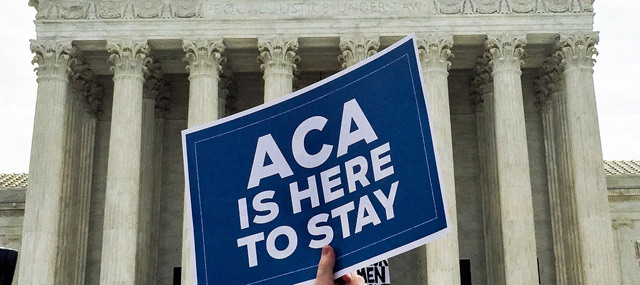Blog
The ACA Survives for Now, But We Still Don’t Have Real Healthcare Reform

Perhaps the best window to the top winners in the Supreme Court ruling on the Affordable Care Act could be seen 200 miles up the road, on Wall Street.
Within minutes of the decision, health care industry stocks were soaring, led by hospital and insurance corporations.
HCA, the biggest U.S. hospital chain, stock immediately jumped 9 percent. Stock for another giant for-profit hospital chain Tenet Healthcare rose 6 percent. Health insurance stocks were also booming for corporate giants Aetna, Cigna, and Anthem.
The bubbly reaction by the traders was a punctuation mark for the most quoted phrase from Chief Justice John Roberts’ 6-3 majority decision, "Congress passed the Affordable Care Act to improve health insurance markets, not to destroy them."
The Court ruling does provide a reprieve for several million low and moderate-income people who depend on federal tax subsidies to buy private health insurance, as now required by the ACA.
Yet, as Roberts signaled, the decision is ultimately a reminder that the ACA, based on a model developed by corporate think tanks and a Massachusetts law enacted under former Republican governor Mitt Romney, has served first and foremost to further cement and expand the insurance-based private healthcare system in the U.S.
Following passage of the ACA, healthcare industry profits, which dipped during the 2008 Wall Street collapse, have soared to record levels.
The ACA mandated millions of new customers for the private insurance companies. With its financial incentives for electronic health records, the law encouraged a huge windfall for information technology firms. Added payments for drugs, and the refusal to allow the federal government to negotiate bulk discount rates from the pharmaceutical giants, encouraged accelerated drug profits.
And big hospital chains are also back making record profits, with the assist of more payments from insurers and the failure to set any real limits on hospital price gouging. In fact, the ACA encourages corporate consolidation that drives up prices.
Those are all the “markets” Chief Justice Roberts so adroitly noted the Act was intended to improve.
But in daily practice, the world nurses see every day at the bedside, the picture is decidedly mixed.
With its limits on disgraceful insurance restrictions, the ACA has certainly helped patients and families who were shut out by insurers for pre-existing conditions, dropped when they got sick, or financially devastated by caps on coverage.
Yet un-payable medical bills remain the leading cause of personal bankruptcy as the law’s failure to set meaningful cost controls still leaves far too many patients with bills they can not pay, or choosing to skip needed medical care because of the high cost.
In a comprehensive analysis on the eve of the Court ruling in Harpers magazine, Columbia Journalism Review contributing editor Trudy Lieberman aptly deconstructs “the failed promise of the Affordable Care Act.”
At the center of this huge shortfall is what Lieberman calls the “Great Cost Shift” – how the law promotes “the transfer of the growing price of medical care to patients themselves through high deductibles, coinsurance, copayments, and limited provider networks,” especially by encouraging employers to offer scaled back or skeletal health coverage.
For patients sent into the ACA’s health exchanges, whether the state or federal versions, average deductibles, even in the least expensive bronze policies, are a whopping #5,181 for individuals and $10,545 for families.
Even for families on limited incomes who will, as a result of the Court ruling, still get the federal subsidies to buy the health plans in the first place, that math is daunting – one reason, Lieberman quotes an analyst noting we’re replacing the crisis of un-insurance with underinsurance, and a reason from a fourth to a third of people who signed up on the federal or state exchanges the first year have declined to renew.
The key point here, as Lieberman emphasizes, is the conservative ideological framework of market-based medical care, which undergirds the ACA. Without effective controls on profiteering and price gouging, the ACA and market solution for cost controls is, as one of her health policy experts Jonathan Oberlander of the University of North Carolina notes, “making sick people pay more.”
Ultimately, it means the ACA has helped a number of people get into a system that previously shut them out, but it has not come close to solving our long healthcare nightmare. And, by its structure, it never will.
America’s nurses have long campaigned for genuine, comprehensive health care reform, the fundamental idea, as most other industrialized countries have long held, that everyone should be guaranteed access to a single standard of safe therapeutic care.
Until we have a humane healthcare system in place that is not based on ability to pay, age, gender, ethnicity, or where you live, healthcare will continue to be a privilege, oriented to profits, not based on patient need.
That is precisely why nurses are continuing to campaign for expanding and updating Medicare to cover everyone.
July 30 marks the 50th anniversary of the enactment of Medicare, achieved against the considerable opposition of the healthcare industry (including one of their leading spokesmen, an actor named Ronald Reagan).
National Nurses United will be joining with labor, community, and healthcare activists across the country in events across the U.S., to mark the occasion, and remind us of the need to continue fighting for the real solution for healthcare reform. To join the actions, look for details at http://www.medicareturns50.org.